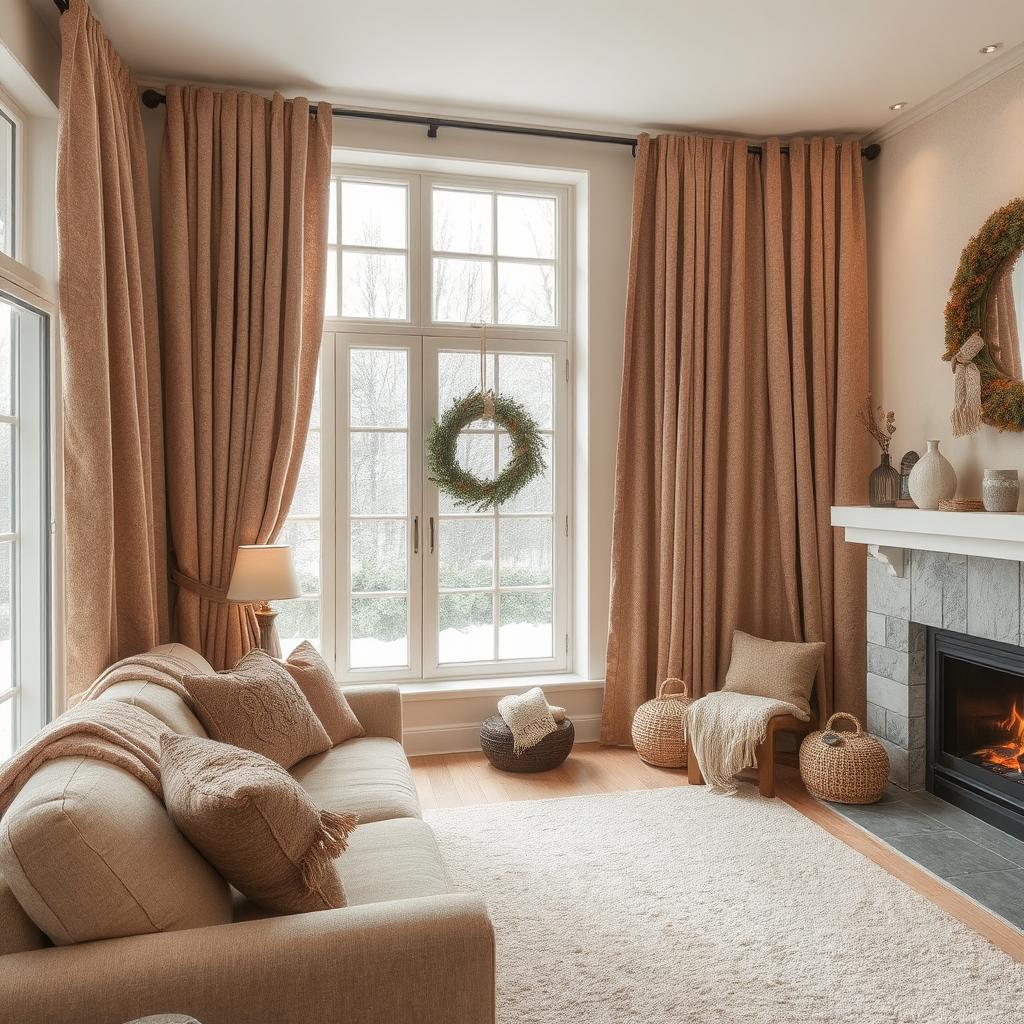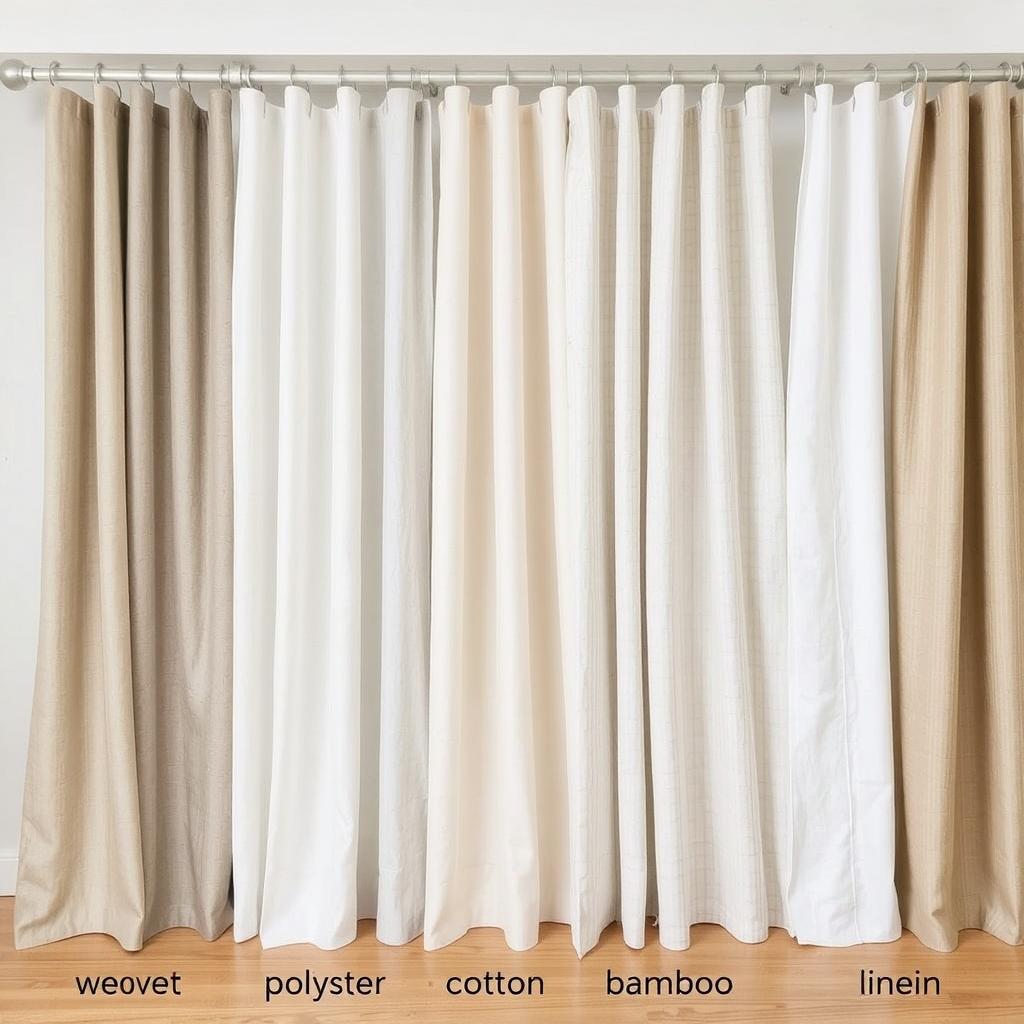As the temperature drops and winter sets in, one of the easiest ways to keep your home cozy and warm is by choosing the right winter curtains. Not only do curtains enhance the overall look of a room, but they also play a crucial role in regulating the indoor temperature. Thick, insulated curtains can block drafts and prevent heat from escaping, ensuring that your space stays snug and energy-efficient.
When it comes to winter curtain options, you’ll find a variety of materials, each offering different levels of warmth, style, and maintenance. From luxurious wool curtains that trap heat naturally, to velvet curtains that add a touch of elegance while keeping the cold at bay, your choice can significantly impact the comfort of your home during the colder months.
In this post, we’ll compare seven of the best curtain materials for winter: wool, velvet, polyester, cotton blends, faux silk, bamboo, and linen. Whether you’re looking for energy-efficient curtains to help lower heating costs or a stylish way to add warmth to your living room, this guide will help you make the right choice for your winter needs.
Keep reading to learn more about each curtain type’s insulating properties, maintenance requirements, and the pros and cons of each option. Whether you’re updating your bedroom, living room, or home office, we’ve got you covered with the best recommendations for winter curtains.
1. Wool Curtains for Winter
When winter arrives, one of the best ways to keep your home warm is by investing in wool curtains. Wool is a natural insulator, so it helps trap heat inside your room while blocking cold air from entering. This makes wool curtains an excellent choice for cold winter months. Their dense texture creates a barrier against drafts, keeping the warmth in and the chill out.
Not only do wool curtains provide insulation, but they also bring a luxurious look to any room. The rich texture and natural sheen of wool make your windows look sophisticated and elegant. They’re eco-friendly too, as wool is a renewable and biodegradable material.
However, wool curtains can be heavier than other types, so make sure your curtain rods are sturdy enough to support them. Also, they require dry cleaning or delicate care to maintain their appearance, making them a bit high-maintenance. Despite this, wool curtains are a fantastic investment if you’re looking for energy-efficient curtains that will keep your home cozy in winter.
2. Velvet Curtains for Winter
Velvet curtains are perfect for winter, offering both style and warmth. Velvet’s dense and plush fabric helps insulate your home, trapping heat and keeping the cold air outside. This makes velvet an ideal choice for anyone wanting a chic, cozy look during the colder months.
One of the standout benefits of velvet curtains is their luxurious appeal. Their soft texture and rich, deep colors can instantly elevate any room. Whether you choose jewel tones or muted hues, velvet curtains add a sense of warmth and sophistication.
However, velvet curtains can be a bit heavy and require special care. They often need to be dry cleaned to maintain their texture and avoid damage. Despite the care they need, velvet curtains are a great choice for anyone looking to create a cozy, elegant winter haven.
3. Polyester Curtains for Winter
If you’re on a budget but still want good insulation for the winter, polyester curtains are an affordable and practical option. Polyester is a synthetic fabric that offers decent thermal insulation. It keeps warmth inside while blocking drafts, making it a great choice for chilly weather.
Polyester curtains are also incredibly easy to care for. Unlike natural fabrics like wool or velvet, polyester curtains are machine washable, which makes them more convenient for daily use. They are also lightweight, so you won’t need heavy-duty curtain rods.
While polyester curtains are budget-friendly and low-maintenance, they don’t provide the same luxurious look as wool or velvet. They might not feel as rich or as thick, but they can still do the job of keeping your home warm and stylish.

4. Cotton Blend Curtains for Winter
Cotton blend curtains offer the perfect balance between natural and synthetic fibers, making them a great option for winter. A cotton blend combines the breathability and softness of cotton with the durability and insulation properties of synthetic materials like polyester. This combination creates a curtain that is soft, functional, and can help regulate indoor temperature during winter.
Cotton blend curtains are easy to care for, as they’re usually machine washable, which makes them a practical option for busy homes. They also come in a variety of colors and patterns, so you can easily match them with your room’s decor.
While they provide decent insulation, cotton blend curtains aren’t as effective as wool or velvet when it comes to blocking cold drafts. Still, they can be a good option if you’re looking for affordable, low-maintenance curtains that still offer warmth in winter.
5. Faux Silk Curtains for Winter
For a touch of luxury without the high cost, consider faux silk curtains. These curtains have the same rich appearance as real silk but are more affordable and easier to maintain. Faux silk fabric is smooth and elegant, making it an excellent choice if you want to add a sophisticated touch to your winter decor.
Faux silk curtains can provide some insulation, but they are not as effective as wool or velvet in trapping heat. They are best used in spaces where you want to create a stylish look rather than rely on them for insulation alone. Faux silk is also low-maintenance—it doesn’t require dry cleaning and can be cleaned with a gentle cycle in the washing machine.
While they offer a glamorous look, faux silk curtains may not be as effective in extremely cold climates. They are better suited for rooms where you want to add elegance without sacrificing too much in warmth.
6. Bamboo Curtains for Winter
If you’re looking for eco-friendly winter curtains, bamboo curtains are a great option. Bamboo is a sustainable material that helps create a natural and cozy atmosphere in any room. While bamboo curtains don’t provide as much insulation as wool or velvet, they still offer a decent level of temperature regulation.
One of the benefits of bamboo curtains is that they are naturally moisture-wicking, making them great for rooms that tend to get damp or humid in the winter. Bamboo curtains are also relatively lightweight, which makes them easy to hang and move around.
However, bamboo curtains might not be as effective at blocking cold drafts as heavier fabrics. They are more suitable for mild winter climates where insulation isn’t the top priority. Still, they provide a unique aesthetic and work well in rooms looking for a natural, boho feel.
7. Linen Curtains for Winter
Linen curtains are a popular choice for a relaxed, natural look. Though linen isn’t known for its insulating properties, it still provides some thermal regulation. Linen’s natural fibers can help keep your home feeling comfortable by blocking some heat from escaping, but they’re not as effective as heavier fabrics like wool or velvet.
Linen curtains are breathable and great for rooms that need a bit of airflow. They’re also durable, which means they’ll last for many winters if well cared for. One downside is that linen can wrinkle easily, and it may require more maintenance than other fabrics.
If you live in a mild winter climate, linen curtains can be a great way to add warmth and texture to your home while maintaining a casual, elegant aesthetic. They offer a unique look that’s perfect for those who prefer minimalistic or bohemian-style interiors.

| Type of Curtain | Material | Insulation | Maintenance | Best For | Pros | Cons |
|---|---|---|---|---|---|---|
| Wool Curtains | Wool | Excellent (Great for winter warmth) | Dry clean, delicate care | Cold climates, winter warmth | Natural insulator, eco-friendly, luxurious look | High maintenance, heavy, expensive |
| Velvet Curtains | Velvet | Very Good | Dry clean, special care | Elegant, cold rooms | Luxurious feel, excellent heat insulation | Expensive, heavy, needs special care |
| Polyester Curtains | Polyester | Good (Moderate warmth) | Machine washable | Budget-friendly, easy care | Affordable, easy maintenance, lightweight | Less luxurious look, not as insulating |
| Cotton Blend Curtains | Cotton + Synthetic | Moderate | Machine washable | Budget-friendly, low-maintenance | Soft, breathable, versatile design options | Less effective insulation, may wrinkle |
| Faux Silk Curtains | Synthetic Silk | Fair (Provides some warmth) | Machine washable (delicate) | Elegant, luxurious spaces | Affordable silk look, easy care | Not ideal for extreme cold, delicate material |
| Bamboo Curtains | Bamboo | Fair (Some insulation) | Easy care (dusting or light wash) | Eco-friendly, light look | Sustainable, moisture-wicking, unique style | Not highly insulating, light fabric |
| Linen Curtains | Linen | Low to Moderate | Machine washable | Casual, mild winter climates | Light, breathable, natural texture | Low insulation, wrinkles easily |
Conclusion
Choosing the right curtains for winter is all about finding the perfect balance between warmth, style, and practicality. Wool curtains stand out for their exceptional insulation and cozy feel, making them ideal for colder months. However, other options like velvet, polyester, cotton blends, faux silk, bamboo, and linen each offer unique benefits that can suit different needs and preferences.
If you’re looking for luxury and warmth, wool curtains or velvet curtains are your best bet. For those on a budget, polyester and cotton blend curtains provide a practical solution with easy maintenance. Bamboo and linen curtains, while eco-friendly and breathable, might not offer the same level of warmth, but they are great for milder winters.
Ultimately, the best choice depends on your priorities—whether you need heavy insulation, a sleek look, or easy care. Consider factors like room temperature, aesthetics, and maintenance to find the perfect curtains to complement your winter decor.
No matter which curtain type you choose, investing in the right material can transform your space, making it more comfortable and inviting during the chilly months.



